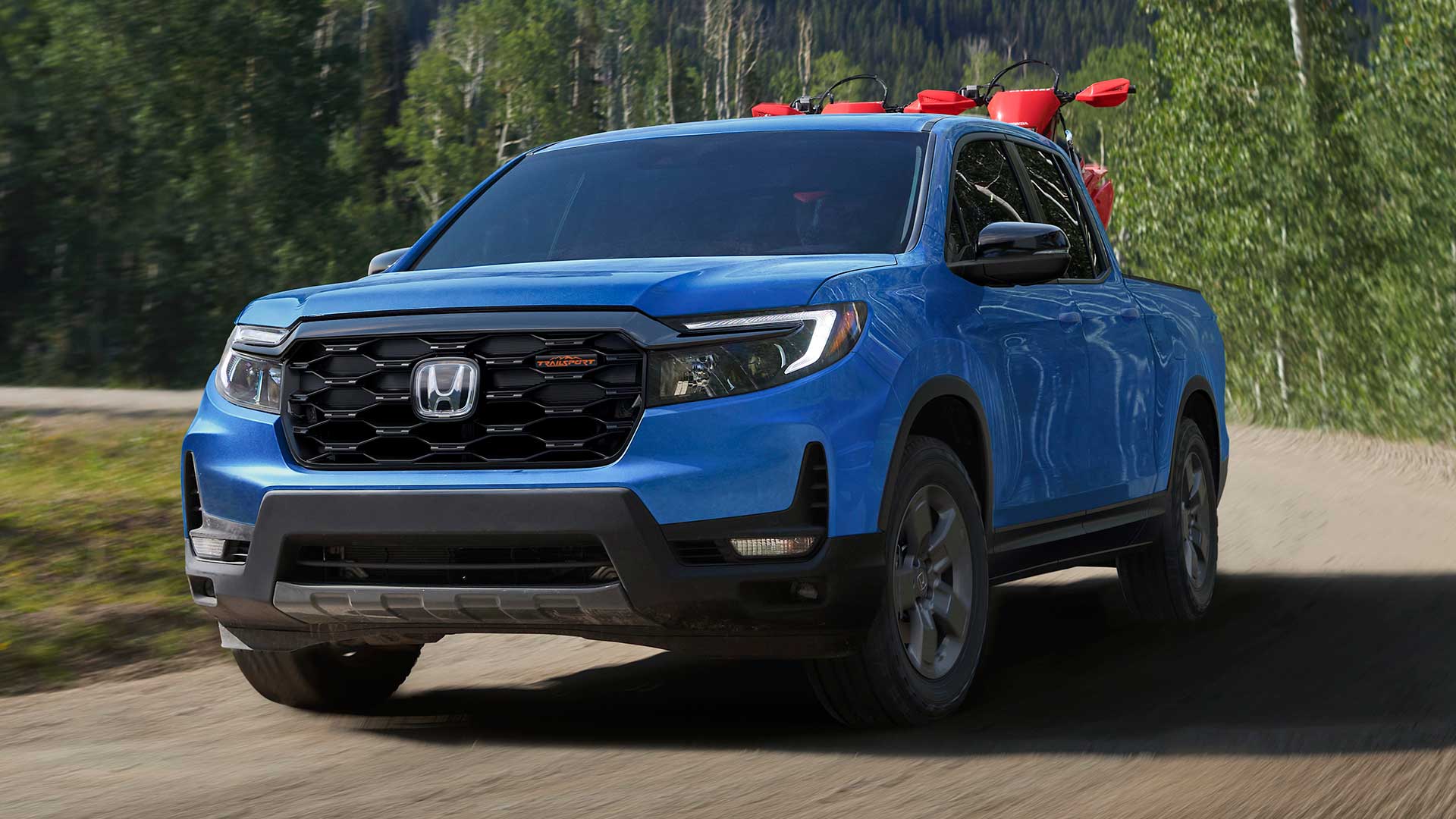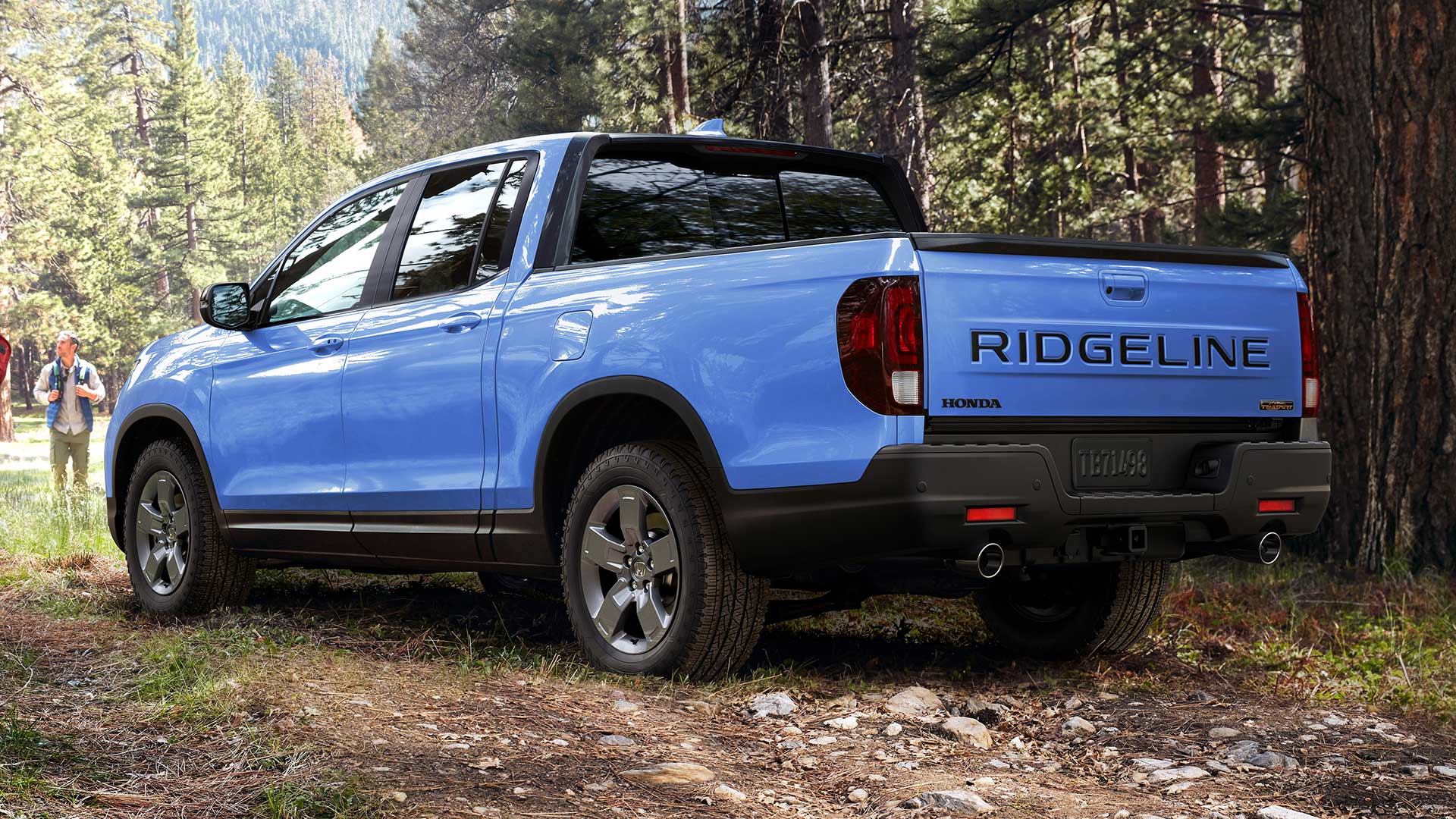2015 Bentley Flying Spur V8
Last year, the Bentley Flying Spur dropped Continental from its name, but it lost nothing when it came to showcasing British luxury performance motoring at its best. Well, this year it loses something else…4-cylinders from its signature W12 engine. So, let’s see if less turns out to be more.
Yes folks, as much as we hate to admit it, sometimes you can have too much of a good thing. That’s where this 2015 Bentley Flying Spur V8 comes in.
For some, 12-cylinders pumping in harmony to produce glorious amounts of power is just more than they can handle or perhaps wish to pay for.
But this is no lightweight V8 we’re talking about here. It’s Audi’s aluminum 4.0-liter twin-turbo unit that, after some unique Bentley tweaks, performs some internal combustion magic of its own, pulling 500-horsepower and 487 lb-ft. of torque. That may be over 100-horsepower less than the W12, but with 100-pounds of weight also removed from the front end, it should translate to a more enjoyable experience at the track.
So we “suited up” in proper Bentley fashion and made haste to our test facility. And unless you’ve recently driven the W12 Flying Spur, you’d be hard pressed to notice a difference in acceleration, as this thing just flat takes off. There’s gobs of power off the line, and rear-biased all-wheel-drive to apply it.
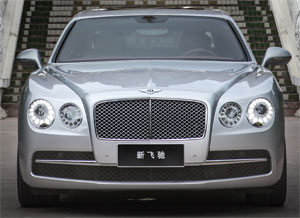 Power continues to build in a very linear fashion, and 60 miles-per-hour arrives in just 4.6-seconds. That’s only a tenth off our time in the W12. The 8-speed automatic transmission provided smooth and fast shifts, and in 12.9-seconds, we were at the end of the ¼-mile with the needle pointing at 111 on the speedo. So, unless you absolutely will settle for nothing but the best or are always in a real hurry, there’s not much need for the 12.
Power continues to build in a very linear fashion, and 60 miles-per-hour arrives in just 4.6-seconds. That’s only a tenth off our time in the W12. The 8-speed automatic transmission provided smooth and fast shifts, and in 12.9-seconds, we were at the end of the ¼-mile with the needle pointing at 111 on the speedo. So, unless you absolutely will settle for nothing but the best or are always in a real hurry, there’s not much need for the 12.
At 5,300-pounds plus, there’s still a lot of weight to hustle through the cones. But this Flying Spur does so with surprising agility, though you want to make sure suspension is at its firmest setting to keep body roll at a minimum. You can find both under and over steer should you go looking, but initiating either requires some very aggressive inputs with the wheel or with the throttle.
Even more amazingly, bringing this 2½-ton dreamliner to a halt from 60 happens in just 107-feet, with smooth and steady stops that belie the frictional ferociousness that is transpiring behind this car’s 21-inch painted alloys.
Though technically no longer part of the Continental family, the Flying Spur sees similar exterior embellishments to last year’s Continental GT Coupe V8. That means it’ll take a keen or perhaps distinguished eye to spot the dark finish to the grilles, red background of the flying B logo, and figure-8 shaped exhaust finishers.
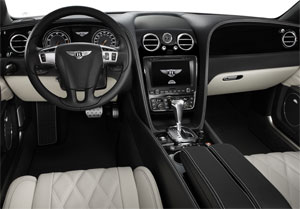 There’s always lots to love when you’re talking about Bentley interiors. Now, we can’t say this Newmark tan motif would be our first choice in color as we prefer to leave the saddle-brown theme to our pickups, but material quality and finish are every bit as exquisite as you would expect.
There’s always lots to love when you’re talking about Bentley interiors. Now, we can’t say this Newmark tan motif would be our first choice in color as we prefer to leave the saddle-brown theme to our pickups, but material quality and finish are every bit as exquisite as you would expect.
Amenities include beautiful Eucalyptus wood veneer, picnic trays, Naim for Bentley Premium Audio, refrigerated bottle cooler, massaging seats, full length center console with seating for just two in the back, dual LCD screens, and a remote to control most of the cars functions from the back seat.
If you’re smart enough to send the chauffeur home for the day and take up residence in the front seat, you’ll agree that this may be the best handling close to 3-ton sedan out there. It does indeed feel massive, but highly capable and stable. Just plan ahead a bit for turns as there’s no dartiness to it.
While this basic chassis has been around for quite some time, and we wonder just how much further corporate parent Volkswagen can go with it, does the average luxury buyer really care about any of that? Probably not, and you won’t either. Just relax and enjoy the ride.
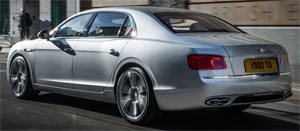 Despite the smaller V8 engine, there’s still a gas guzzler tax, as Government Fuel Economy Ratings come in at 14-City, 24-Highway, and 17-Combined. Our average of 18.0 miles-per-gallon of Premium was around 8% better than we achieved in the W12 Flying Spur. That still makes for a very poor Energy Impact Score however, burning through 19.4-barrels of oil per year while expelling 8.5-tons of CO2.
Despite the smaller V8 engine, there’s still a gas guzzler tax, as Government Fuel Economy Ratings come in at 14-City, 24-Highway, and 17-Combined. Our average of 18.0 miles-per-gallon of Premium was around 8% better than we achieved in the W12 Flying Spur. That still makes for a very poor Energy Impact Score however, burning through 19.4-barrels of oil per year while expelling 8.5-tons of CO2.
Priced about $20,000 under the W12 at $200,245, it may be the everyman’s Flying Spur, but it’s still not for every man or woman; more for those with the necessary “funds” be they trust, hedge, or otherwise.
Much as in the Continental GT Coupe, the V8 engine in the 2015 Bentley Flying Spur sedan makes for a better overall car. Sure, in the luxury realm there is always an accepted space for prestigious overkill. But as far as we’re concerned, this is a case of less is more.
Specifications
- Engine: 4.0 liter
- Horsepower: 500
- Torque: 487 lb-ft.
- 0-60 mph: 4.6 seconds
- 1/4 mile: 12.9 seconds @ 111 mph
- EPA: 14 mpg city/ 24 mpg highway
- Energy Impact: 19.4 barrels of oil/yr
- CO2 Emissions: 8.5 tons/yr
2024 Honda Ridgeline TrailSport
It Does Truck-Like Things Better Than Ever
Honda brought something truly unique to the pickup truck scene when their mid-size Ridgeline debuted for 2006. In 2017, it moved towards becoming a little more true truck-like, both in form and capability, now with yet another step in that direction for 2024. So, let’s see if the Ridgeline is really hitting its stride.
For 2024, it’s all about making this Honda Ridgeline better than ever. There are styling tweaks outside, along with tech and functional improvements inside, but the biggest news is the Ridgeline has now joined Honda’s TrailSport family of off-road inspired vehicles. This more-true-trucklike, second-gen Ridgeline been around since 2017, receiving periodic updates over the years; but joining the TrailSport family is the biggest leap yet.
Primarily, the TrailSport transformation includes General Grabber all-terrain tires, mounted on new Pewter Gray 18-inch wheels, steel underbody protection, and retuning the strut front, and multi-link rear suspension for added wheel articulation. And while we always appreciate the additional traction of off-road tires, the Ridgeline’s standard i-VTM4 all-wheel drive, with Intelligent Traction Management and snow, sand, and mud settings, was already quite capable of handling all but the most extreme off-roading, ground clearance of just 7.6 inches being it’s only real hinderance.
A 3.5-liter V6 remains under the hood as it has since the Ridgeline debuted for 2006; the current version outputs 280 horsepower and 262 lb-ft of torque, plenty enough muscle to handle its 5,000-lbs. towing capacity. A nine-speed automatic transmission with paddle shifters and bevy of push and pull buttons on the console replaced the six-speed automatic back in 2020.
In addition to adding TrailSport capability, a big focus for this update was making it more user-friendly inside, starting with the central touchscreen growing from 8 to 9 inches. It also gets faster processing speeds, menus have been simplified, and the native navigation system is improved with better graphics. It’s accompanied by a new digital instrument cluster, along with an upgraded center console with more storage space. Unique TrailSport touches include heavy duty floormats, leather-trimmed seats, orange stitching throughout the cabin, and orange ambient lighting.
The Ridgeline continues to offer things available nowhere else in the pickup truck market.
Exterior styling doesn’t exactly shout “macho big rig coming your way,” but the more vertical face and larger grille that arrived for 2021, along with this year’s added TrailSport elements, do continue to toughen up the Ridgeline’s image. The 5’4” bed remains highly functional with no large wheel well intrusions, multiple tie-downs points, lighting and even speakers. And of course, the Ridgeline continues to offer things available nowhere else in the pickup truck market, like the dual-action tailgate, and large, lockable, drainable, underbed storage. Not to mention being able to drive around in true car-like comfort, something we took full advantage of on our way to our Mason Dixon Dragway test track.
There was great grip off the line, with full power arriving smoothly but quickly, helping us to get to 60 in 7.0 seconds flat, a tenth quicker than the last Ridgeline we tested. That power delivery stayed fairly consistent the whole way down the track, barely interrupted by the nine-speed automatic’s smooth shifting. Our best quarter-mile run was 15.5 seconds at 90 mph.
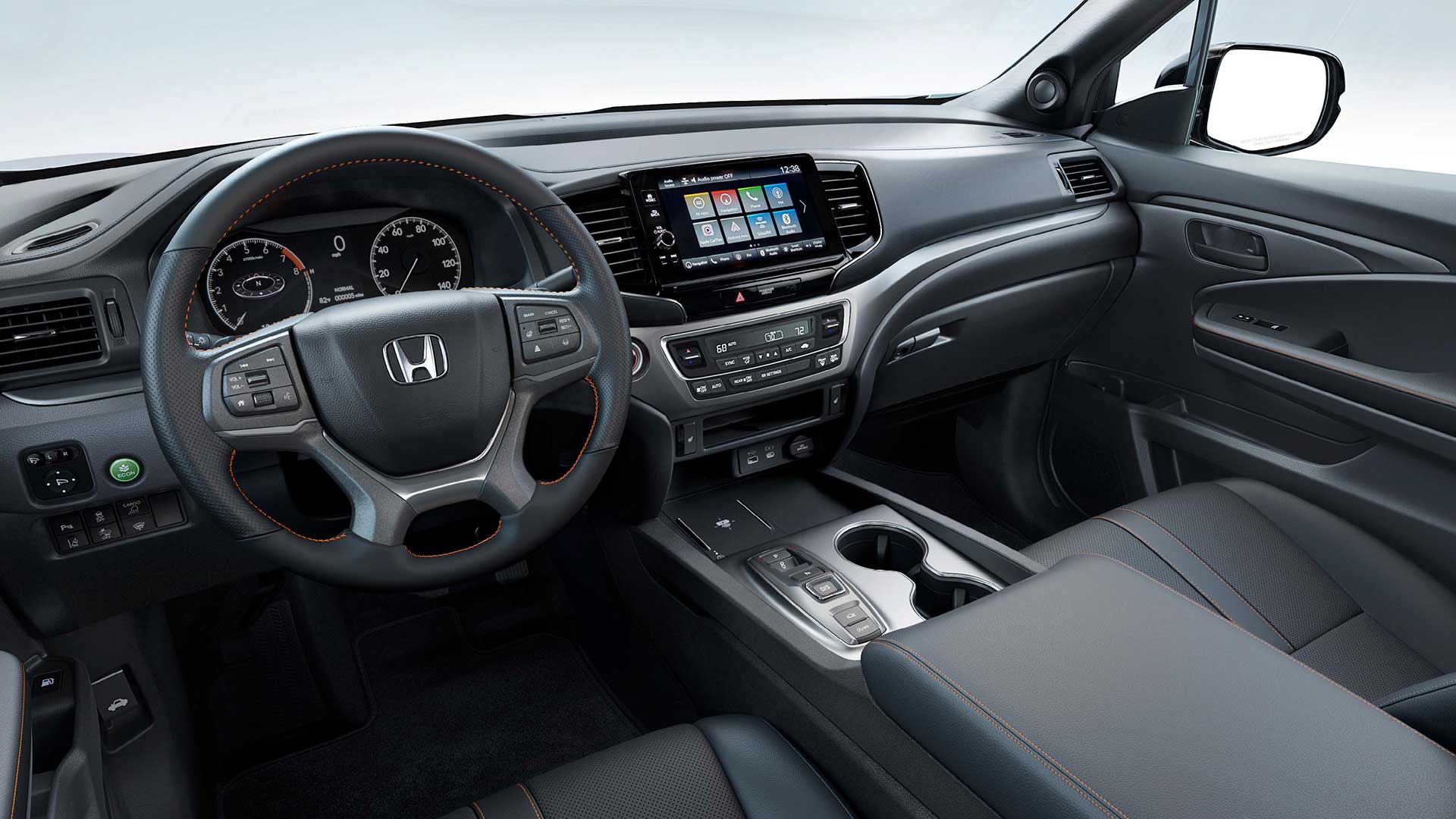
The revised suspension and knobbier tires didn’t really seem to add or detract from handling prowess, as it felt as solid, nimble, and car-like as it always has through our cone course. Perhaps a little less stiff than before, but good feedback, tight steering, and minimal body roll for a pickup, made for a very confidence inspiring experience. In our braking test, we stopped in a respectable average of 123 feet from 60, with only moderate amounts of nosedive and good feel through the pedal.
There is, however, a slight reduction in Government Fuel Economy Ratings with the all-terrain tires; 18-City, 23-Highway, and 20-Combined, our average, right on, at 20.4 mpg of Regular. That’s a slightly below average Energy Impact Score of 14.9 barrels of yearly oil use, with CO2 emissions of 7.4 tons.
TrailSport pricing falls in line just under the Ridgeline’s top Black Edition trim with a starting price of $46,375, about five grand over a base Ridgeline Sport.
So, whether you consider the Honda Ridgeline to be a “real” truck or not, this ruggedly smooth 2024 TrailSport does truck-like things better than ever. And we’re not just talking about the slight upgrade in off-road performance, we’re talking about a flexible bed to help you get chores done, and the ability to tow or haul with comfort and flexibility other trucks can only wish for. It’s why the Ridgeline brings more first-time buyers to Honda than any other vehicle, and why it continues to be a great choice in the growing midsize truck realm.
Specifications
- Engine: 3.5-liter V6
- Transmission: 9-speed automatic
- Horsepower: 280
- Torque: 262 lb-ft
- EPA: 18 City | 23 Highway | 20 Combined
- 0-60 mph: 7.0 seconds
- 1/4 Mile: 15.5 seconds at 90 mph
- 60-0 Braking (avg): 123 feet
- MW Fuel Economy: 20.4 mpg (Regular)
- Max Towing Capacity: 5,000-lbs








